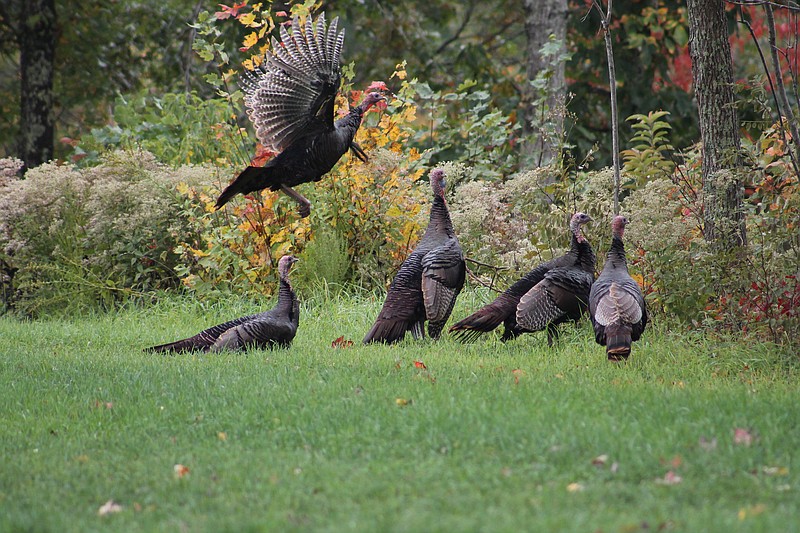Kee! Kee! Kee! The calls coming from the jake turkey were piercing now. I could hear the crunching of the dry leaves as he came up the hill below me.
This turkey was close, and I nervously moved my eyes back and forth over the landscape in front of me, looking for where he might pop up. The shotgun on my knee was pointed at my best guess for where he would appear as I waited on that October hillside.
They say variety is the spice of life. I think most hunters would agree. Many of us tend to do more than one type of hunting. I know several deer hunters who also enjoy the pursuit of small game or maybe turkeys.
When it comes to turkeys, though, many of us think only about the charms of the spring gobbler season. Most turkey hunters don't even consider fall hunting. This is a mistake. The fall hunt has a deep heritage, and a world of turkey hunting fun awaits those who will explore it.
The fall season has a long tradition, much longer than the spring season, but in recent years the spring hunt has definitely taken over the limelight. We now have an entire generation of hunters who may have never hunted turkeys in the fall.
Just as the hunt for wild turkeys has a long tradition, the management and recovery efforts centered on turkeys has as well. It wasn't easy, but after wildlife biologists learned what to do, the turkey population took off. The following is taken from a report done by Keith Krantz, a wildlife biologist with the West Virginia Division of Natural Resources and former head of the turkey and upland game project.
In West Virginia, efforts to bolster the state's turkey population began in 1928 with releases of game farm birds raised at the French Creek Game Farm. Release efforts slacked off in 1940 when it became evident that game farm birds did little to help local populations.
Renewed efforts involving a "wild-mating" system in the early 1940s also resulted in failure. Under this system, game farm hens were held in pens designed to permit entry of wild gobblers for mating. It was hoped that such a breeding system would result in offspring with increased vigor and wildness. This system failed as well.
Recognizing the futility of using game farm turkeys in restocking ultimately resulted in redirected efforts to live-trap and transplant wild birds. However, early trapping efforts were failures due to the lack of an acceptable trap. Using cage-type traps resulted in the capture and release of six birds at Coopers Rock State Forest in 1950 and nine birds at Bluestone Wildlife Management Area in 1953. A full-time trap and transplant project began in 1953 with the adoption of the cannon-net for use in trapping operations. Transplant efforts using live-trapped wild birds were extremely successful.
The wild turkey trap and transplant program was completed in early 1989 and resulted in 2,262 turkeys being moved to 32 counties. Turkeys expanded from 62 stockings in these 32 counties to an additional seven counties. The program was responsible for restoring turkeys to 39 counties. Turkeys now exist in all 55 counties. West Virginia's wild turkey population in 2013 was estimated at 110,510 birds (assuming the spring gobbler harvest represents 10% of the population), and more than 75% of these occur in counties restocked with wild-trapped birds.
So you can see from Krantz's report that we have come a long way with our wild turkey population in West Virginia. Krantz, as well as his predecessor biologists Curtis Taylor, Jim Pack and the "Godfather of Wild Turkey Management," Wayne Bailey, are all owed a measure of gratitude from West Virginia hunters. Thank you, from one turkey hunter to another.
The fall season will never have the popularity of the spring fling for turkeys, and maybe that is OK. In the spring gobbler season it is the only game in town; there is no deer archery season or other things to distract the turkey hunter's attention. The turkeys are considered more loud and boisterous in the spring (don't tell anyone, but they gobble in the fall, too), and like I said, we have many hunters who have never fall turkey hunted, so it is not a tradition for them.
But once upon a time, the fall season was a long-awaited event for many hunters, who roamed the woods trying to find turkey "scratching" and other sign to scatter a flock, then sit and hopefully call one into the old double-barrel on their lap.
That old tradition is increasingly rare these days. Here's hoping we never lose it completely.
"Guns & Cornbread" is written by Larry Case, who lives in Fayette County, W.Va. You can write to him at larryocase@gmail.com.
